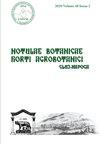台湾橄榄本地品种的微繁研究
IF 1.3
4区 生物学
Q3 PLANT SCIENCES
引用次数: 0
摘要
橄榄(Olea europaea L.)是世界上最古老的栽培水果之一。土生橄榄品种(土生土耳其橄榄品种)的果实和油具有独特的感官特性(味觉、嗅觉和香气),近年来越来越受到重视。尤其是橄榄油公司,他们在寻找那些在油中有独特味道、气味和香气的品种。橄榄品种的扦插和嫁接繁殖是非常困难和昂贵的,因此寻找容易和大量繁殖的解决方案是很重要的。微繁繁殖特别有利于繁殖常规繁殖难以繁殖的植物或确保无病毒植物或具有特殊品质的植物。本研究以安那托利亚东南部橄榄产地本文章由计算机程序翻译,如有差异,请以英文原文为准。
Micropropagation of autochthonous olive varieties from Türkiye
Olive (Olea europaea L.) is one of the oldest cultivated fruit species in the world. Fruits and oils of autocthonous olive varieties (native Turkish olive varieties) with unique sensory properties (taste, smell and aroma) gain importance recently. Particularly olive oil companies looking for varieties that have distinct taste, smell and aroma in their oil. Propagation of olive varieties by cuttings and grafting is very difficult and expensive, therefore it is important to find solution for easy and mass propagation. Micropropagation is particularly beneficial to propagate plants that are difficult to reproduce conventionally or to ensure virus-free plants or plants with particular qualities. In this study, in vitro micropropagation success of two autocthonous olive varieties (‘Mavi’ and ‘Guleki’) grown in the origin center of olive, Southeast Anatolia, Türkiye was investigated. Both varieties, have distinct smell, taste and aroma and are difficult to root by cuttings. The effects of three different medium OM (Olive Medium), WPM (Woody Plant Medium) and DKW (Driver-Kuniyuki Walnut Medium) and two different growth regulators BAP (6-Benzylaminopurine) and Zeatin on shoot induction (proliferation) in the in vitro micropropagation of the olive varieties were examined. Obtained shoots were later subjected to in vitro rooting and acclimatization. The highest proliferation efficiency and shoot length for both varieties were obtained with the use of 1 mg Zeatin+0.1 mg GAɜ hormone combinations on OM medium. ‘Mavi’ variety formed more roots compared to ‘Guleki’ (3.33 vs. 2.75 per shoots), and gave the highest rooting rate of 74.33% with 2 mg IBA (Indole Butyric Acid) treatment on ½ OM medium. In terms of rooting rate, Guleki gave the highest rooting (100%) on medium containing ½ OM, 0.2 mg GA3 and 4 mg IBA. 60% and 75% of the micropropagated plants of ‘Mavi’ and ‘Guleki’ varieties adapted well to the external conditions.
求助全文
通过发布文献求助,成功后即可免费获取论文全文。
去求助
来源期刊

Notulae Botanicae Horti Agrobotanici Cluj-napoca
PLANT SCIENCES-
CiteScore
2.70
自引率
0.00%
发文量
118
审稿时长
3 months
期刊介绍:
Notulae Botanicae Horti Agrobotanici Cluj-Napoca is a peer-reviewed biannual journal aimed at disseminating significant research and original papers, critical reviews and short reviews. The subjects refer on plant biodiversity, genetics and plant breeding, development of new methodologies that can be of interest to a wide audience of plant scientists in all areas of plant biology, agriculture, horticulture and forestry. The journal encourages authors to frame their research questions and discuss their results in terms of the major questions of plant sciences, thereby maximizing the impact and value of their research, and thus in favor of spreading their studies outcome. The papers must be of potential interest to a significant number of scientists and, if specific to a local situation, must be relevant to a wide body of knowledge in life sciences. Articles should make a significant contribution to the advancement of knowledge or toward a better understanding of existing biological and agricultural concepts. An international Editorial Board advises the journal. The total content of the journal may be used for educational, non-profit purposes without regard to copyright. The distribution of the material is encouraged with the condition that the authors and the source (Notulae Botanicae Horti Agrobotanici Cluj-Napoca or JCR abbrev. title Not Bot Horti Agrobo) are mentioned.
 求助内容:
求助内容: 应助结果提醒方式:
应助结果提醒方式:


